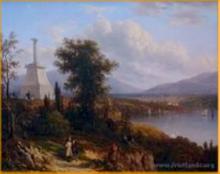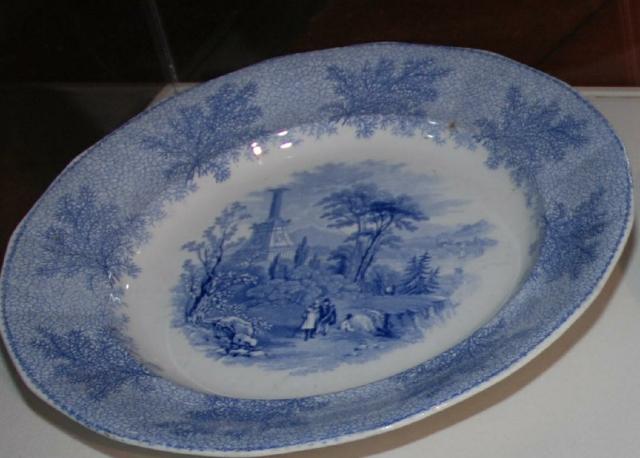
It all took place just here at West Point |
Thaddeus Kosciuszko, the descendent of Polish nobles, arrived in America shortly after the signing of the Declaration of Independence. He went on to become a hero of the Revolution, noted for his skills as a military engineer who built fortifications. In this exclusive excerpt from The Peasant Prince: Thaddeus Kosciuszko and the Age of Revolution, author Alex Storozynski describes how his subject’s deep commitment to human freedom influenced his everyday behavior.
Life in the boondocks of the highlands was monotonous and the workload heavy. Initially the Polish engineer worked long hours and stayed in the nearby boarding house of Mrs. Sarah Warren. But once the threat of a British attack was no longer imminent, and the frenetic pace of construction slowed down, he built a log cabin near the fort to serve as his quarters.
* * *
The close bond that Kosciuszko had with Gen. John Paterson also extended to Paterson’s black servant, Agrippa Hull. While slavery was still legal in the North before the Revolution, Hull, whom everyone called Grippy, was a free man. A witty raconteur, Grippy told stories about his father, who he said was a prince in Africa. His Polish friend cherished this legacy and the verbal history passed down from his ancestors about his roots in Africa. As an ardent student of ancient Rome and Greece, Kosciuszko knew that Agrippa was also the name of a Roman statesman and general and probably would have discussed this with the son of an African prince.
Paterson, seeing the bond between the two, presented his servant to Kosciuszko, and Grippy happily served as the Polish officer’s confidant and aide-de-camp. Often scouting the terrain and approaches to the Hudson Highlands, on one occasion when Kosciuszko set out to reconnoiter the positions on the east side of the river, he left Grippy to watch over his quarters high above the bend in the river, close to where a statue of the Polish revolutionary now stares out over the Hudson. Kosciuszko told his aide that he was headed downstream to cross the river and that he would be gone for two or three days. Grippy took advantage of his officer’s absence and threw a party in the cabin, inviting all the slaves and free black men at the camp.

Yes, the log cabin stood not far away from the place where the West Point Military Academy cadets have built a monument to Kosciuszko, as shown on a plate (from Polish Museum of America collection). Photo Puls Polonii |
The guests drank wine and enjoyed the show put on by Grippy, who paraded around the cabin in the Polish officer’s dress uniform, featuring a navy blue jacket with a crimson collar, golden epaulets, and a four-cornered cap adorned with nodding ostrich plumes. Kosciuszko was wearing his boots when he rode out of camp, so Grippy shined his own legs with black shoe polish to resemble riding boots.
Grippy left the windows open but hung a screen over the door to hide the party from passersby. For some reason Kosciuszko unexpectedly returned the same night, and when he heard the hoopla and laughter reverberating from his quarters, he dismounted from his horse and sneaked inside, where he found the slaves toasting Grippy and calling him “Kosciuszko.”
The stunned revelers acted as if they had seen a ghost or, worse, “Satan himself,” when the real Kosciuszko stepped among them. Expecting to be beaten by the white officer, several of the black men jumped through the windows, and the rest stampeded out the door. Terrified, Grippy fell at Kosciuszko’s feet, cowering and crying, “Whip me, kill me, Massa; do anything with me Mr. General.”
Kosciuszko took Grippy by the hand and said, “Rise, Prince. It is beneath the dignity of an African prince to prostrate himself at the feet of anyone.” He made Grippy wear the plumed hat and marched him across the camp to General Paterson’s quarters. A black man wearing a flashy uniform with ostrich feathers in his cap caught the attention of the soldiers and drew a crowd that followed Kosciuszko as he dragged his servant toward the other officers to mete out punishment for stealing wine and violating his personal belongings.
The soldiers expected that the black man would be whipped for his indiscretions, but Kosciuszko introduced the nattily clad Grippy as a prince from Africa who had come to join the fight. The Pole was so convincing in his introduction that some of the soldiers believed that Grippy was in fact a prince. The officers built an impromptu throne for Grippy, proffering toasts and forcing him to swill wine, brandy, and a cocktail called Hollands, made from Dutch gin distilled from rye, barley, and flavored with juniper berries. The assembled partygoers smoked a peace pipe in honor of their royal guest. Rather than waking up with bloody slash marks on his back from whipping, which was the normal punishment in those times, Grippy woke up with a terrible hangover from all the alcohol he had drunk.
After the war, Agrippa Hull settled in Stockbridge, Massachusetts, started a catering business, bought land, and built a house. For many years Grippy fondly retold this embarrassing story, explaining how his hangover from the forced binge drinking was akin to being crucified. Kosciuszko also gave Grippy one of his prized possessions, a flintlock pistol made by one of Poland’s eminent gun makers for the royal cadets.
From National Review
Alex Storozynski, an award-winning journalist, is president and executive director of the "Kosciuszko Foundation" and author of "The Peasant Prince: Thaddeus Kosciuszko and the Age of Revolution", from which this is adapted with permission.
Same episode was described by F.C. Kajencki in his splendid book " Thaddeus Kosciuszko. Military Engineer of the American Revolution". Reprinted in Puls Polonii
We wish to recommend yet another book about Kosciuszko. It's "Friends of Liberty: Thomas Jefferson, Tadeusz Kościuszko, and Agrippa Hull. A Tale of Three Patriots, Two Revolutions, and a Tragic Betrayal of Freedom in the New Nation" by Gary B. Nash and Graham Russel Gao Hodges, New York 2008.
Link to "Friends of Liberty..."
| 

